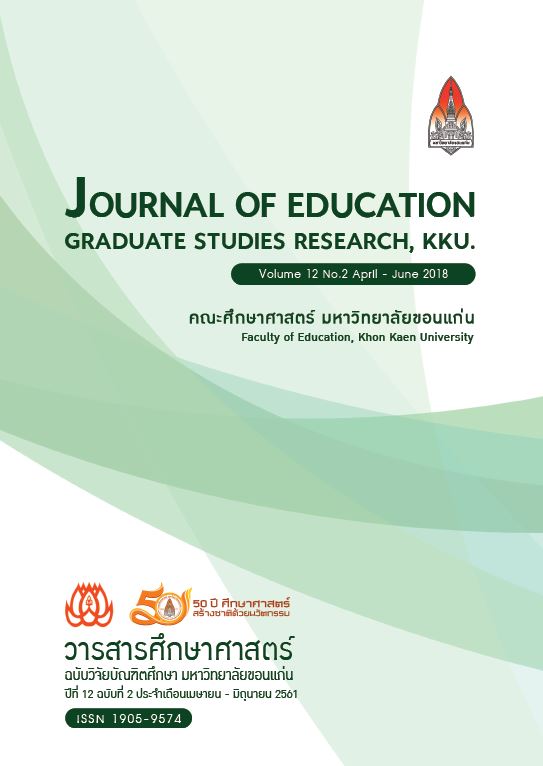The Effect of Constructivist Knowledge Construction Packages to Enhance The Critical Thinking on Topic Health Care for Diabets Patients
Main Article Content
Abstract
From the advancement in technology and science that impact on people living in society. Makes the Thai population is suffering from chronic diseases due to lack of awareness of proper health behaviors leading to more health risk factors. Which is one of the health problem of chronic diseases is complications in diabetes patients. Promoting critical thinking skills to make patients aware of their health care is essential to reduce complications and risk factors to health that may occur. This article presents the results of the Constructivist Knowledgebase. It aims to design and develop the constructivist knowledge construction package, to enhance the critical thinking on topic health care in diabetics, critical thinking and the opinions of learners who learn the constructivist knowledge construction package. The target group were diabetes patients in clinical patients at Kalasin hospital amount of 15 persons, Research design using a form of Pre-Experimental Design, particularly with One Shot Case Study. Analysis of qualitative data by Protocol analysis and analytic description obtained from interviews with learners about critical thinking. And use summary interpretations and lectures to analyze learners' opinions about the constructivist knowledge construction package. The research result found:
- Results of the design and development of Constructivist Knowledge Construction Packages to Enhance The Critical Thinking on Topic Health Care for Diabetes Patients. Found the essential elements of 5 components: 1) Problem base 2) Databank 3) Collaboration 4) Scaffolding and 5) Coaching
- Learners’ critical thinking in this research refers to the critical thinking ability of Ennis (2002), which consist of 5 aspect. The critical thinking was study by analyzing protocol from interviewing learners. From the study, learners thought critically in 5 aspects. Firstly, they though critically in abilities in base for elementary clarification, which were focusing on a question and asking and answering question of clarification. Learners showed critical thinking in one ability in base for the decision, including a judging the credibility of a source. Finally, there was also the ability in proceeding in an orderly manner appropriate to situation, which was an auxiliary critical thinking ability.
- The results of learners’ opinion for Constructivist Knowledge Construction Packages to Enhance The Critical Thinking on Topic Health Care for Diabetes Patients were interpreted in to three areas: contents, learners’ opinion showed that they agree with learning contents. Firstly learners think that content is appropriate and adopt into daily life problem solving. Secondary, learners agree that the design of constructivist knowledge construction packages were designed to help students find the information easily. Finally, learners showed their attitudes toward the design of Constructivist Knowledge Construction Packages to Enhance The Critical Thinking that helped them to identify terms, to consider and organize data. It also encourages the students to interpret and conclusions. That stimulated could be applied to daily life activities.
Article Details
References
นครินทร์. วารสารพยาบาลสงขลานครินทร์, 32(3), 1-10.
จิตติวิทย์ พิทักษ์. (2557). การออกแบบและพัฒนาชุดสร้างความรู้ตามแนวคอนสตรัคติวิสต์ที่ส่งเสริมพหุ ปัญญาทางด้านดนตรี. วิทยานิพนธ์ศึกษา ศาสตรมหาบัณฑิต สาขาวิชาเทคโนโลยีการศึกษา บัณฑิตวิทยาลัย มหาวิทยาลัยขอนแก่น.
บุญถิ่น อินทร์วิเศษ. (2556). มโนมติทางวิทยาศาสตร์ เรื่อง แรงและกฎการเคลื่อนที่ ของนักเรียนชั้น มัธยมศึกษาปีที่ 4 ที่เรียนด้วยชุดการสร้าง ความรู้ตามแนวคอนสตรัคติวิสต์. วิทยานิพนธ์ศึกษาศาสตรมหาบัณฑิต สาขาวิชาวิทยาศาสตร์ศึกษา บัณฑิตวิทยาลัย มหาวิทยาลัยขอนแก่น.
เบาหวาน. (2559). ค้นเมื่อ 10 ตุลาคม 2559, จาก https://th.wikipedia.org/wiki/เบาหวาน.
โรคเบาหวาน รู้สาเหตุ ทางรักษา ไม่อันตรายอย่างที่คิด. (2559). ค้นเมื่อ 10 ตุลาคม 2559, จาก http://www.thailovehealth.com/disease/health-13678.html.
พวงทอง เพชรโทน. (2555). การออกแบบและพัฒนาโมเดลสิ่งแวดล้อมการเรียนรู้บนเครือข่าย ที่ส่งเสริมทักษะทางปัญญาและการคิดอย่างมีวิจารณญาณสำหรับนักศึกษาระดับปริญญาตรี. วิทยานิพนธ์ปรัชญาดุษฎีบัณฑิต สาขาวิชาเทคโนโลยีการศึกษา บัณฑิตวิทยาลัย มหาวิทยาลัยขอนแก่น.
สุมาลี ชัยเจริญ. (2551). เทคโนโลยีการศึกษา: หลักการ ทฤษฎีสู่การปฏิบัติ. ขอนแก่น: คลังนานาวิทยา.
สุมาลี ชัยเจริญ. (2554). เทคโนโลยีการศึกษา: หลักการ ทฤษฎี สู่การปฏิบัติ. ขอนแก่น: หจก.โรงพิมพ์คลังนานาวิทยา.
American Diabetes Association. (2005). Diabetes Care Diagnosis and Classification of Diabetes Mellitus. Retrieved August 11, 2016, from http://care.diabetesjournals.org/content/28/
suppl_1/s37.
Brown, J. S., Collins, A., & Duguid, P. (1989). Situated cognition and the culture of learning. Educational researcher, 18(1), 32-42.
Ennis, R. H. (2002). Super-Streamlined Conception of Critical Thinking (1). Retrieved August 11, 2016, from http://tonydude.net./NaturalScience100/Topics/1Universe/zzcriticalthinking.html.
Klausmeier, H. J. (1985). Educational Phychology. (Sthed). New York: Harper & Row.
Piaget, J. (1964). Part I: Cognitive development in children: Piaget development and learning. Journal of research in science teaching, 2(1), 176– 186.
Vygotsky, L. (1978). Mind in society. London: Harvard University Press.

